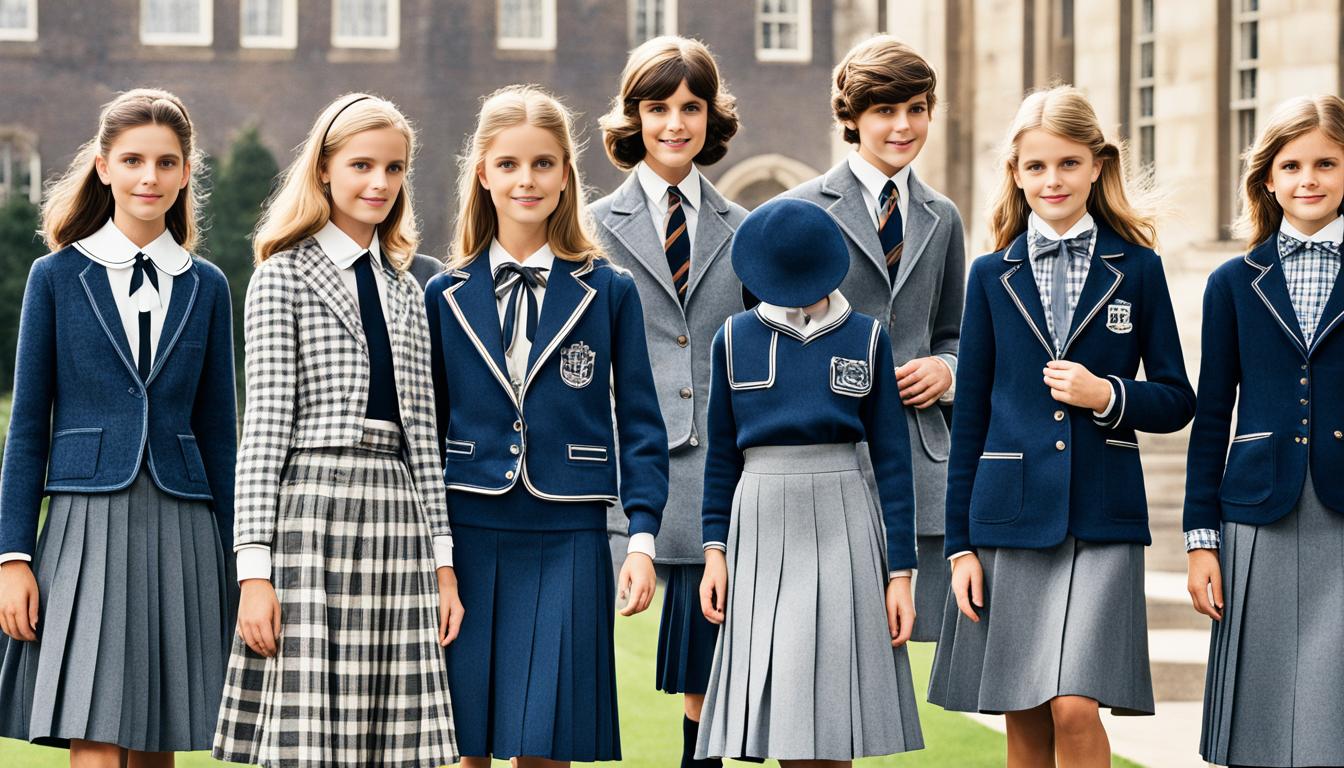Do Boarding Schools Have Uniforms? Yes or No?
Uniforms often spark debate and curiosity regarding school dress codes. While many envision students wearing uniforms in private schools, the question arises: Do boarding schools have uniforms? The answer may not be as straightforward as one might think.
Uniforms are more prevalent in private schools than public schools, and their history and purpose are deeply rooted in tradition and values. However, not all private schools enforce a uniform policy. So, what is the truth behind boarding school uniforms?
In this article, we will explore the topic of school uniforms in boarding schools, examining their history, pros and cons, statistics on uniform use, common styles, and the unique student life experience in boarding schools.
A Brief History of Private School Uniforms
Private schools have a long-standing tradition of implementing standardized dress codes that require students to wear uniforms. The history of private school uniforms dates back to the 19th Century when they were first introduced as a symbol of prestige and discipline.
Private schools adopted uniforms to distinguish themselves from public schools and reinforce their values and traditions. These uniforms typically consisted of blazers, jackets, ties, and skirts or pants, creating a distinctive and professional student appearance.
Over time, private school uniforms have evolved, with specific styles and guidelines varying from school to school. Some institutions maintain a more traditional approach, adhering to strict dress codes, while others have adopted more relaxed guidelines that allow for greater individuality within a standardized framework.
However, regardless of the specific dress code, private school uniforms continue to symbolize discipline, professionalism, and unity.
Today, private school uniforms serve various purposes beyond their historical significance. They promote equality among students by minimizing social and economic disparities that could arise from differences in clothing choices.
Uniforms also simplify the morning routine for students and parents, eliminating the need to decide on appropriate outfits and reducing potential distractions in the classroom.
Furthermore, uniforms can foster a sense of belonging and identity within the school community, strengthening camaraderie and school spirit.
The Symbolism of Private School Uniforms
Private school uniforms serve as a visible representation of the institution’s values and expectations. Uniforms also instill a sense of pride among students, emphasizing their membership in a prestigious educational institution.
🌟 Hey Students! 🚀 Ready for the ultimate experience? Join us on Studentsinside.com's Facebook, YouTube, WhatsApp, and LinkedIn. Click now for tips, fun, and success vibes! 🌈✨ #StudentLife #JoinUs
The history of private school uniforms demonstrates their enduring significance and impact on shaping the school environment. To this day, private schools continue to embrace the tradition of uniforms, recognizing their influence in creating a unified and academically-focused community.
| Year | Key Events |
|---|---|
| 19th Century | Private schools adopt uniforms as a symbol of prestige and discipline. |
| 20th Century | Uniform styles evolve, reflecting changes in fashion and societal norms. |
| Present Day | Private school uniforms continue to be a standard requirement, albeit with variations in dress codes. |
Debating the Pros and Cons of School Uniforms
In the ongoing discussion surrounding school uniforms, both proponents and opponents offer compelling arguments. Those in favor of school uniforms argue that they can positively impact discipline and academic performance.
On the contrary, opponents of school uniforms believe they impose limitations on self-expression and hinder individuality. They argue that allowing students to express their style through clothing choices contributes to their overall well-being and identity development.
Research on the effectiveness of school uniforms has yielded mixed results. Some studies suggest that uniforms can improve discipline and academic outcomes, fostering students’ sense of belonging and equality. However, other studies have found no significant correlation between school uniforms and academic performance.
Ultimately, the decision to implement school uniforms should consider each school community’s unique needs and values. It is essential to weigh the potential benefits of improved discipline and focus on the limitations of self-expression. Schools must also consider the diverse perspectives of students, parents, and faculty members when making such a policy.

Statistics on Uniform Use in Private Schools Today
Uniform policies in private schools play a significant role in establishing a sense of identity, discipline, and unity among students. Understanding the prevalence and extent of uniform use in Catholic and independent schools is essential. Let’s delve into the statistics to understand the current landscape better.
Uniform Policies in Catholic Schools
The requirement for uniforms in Catholic schools is widespread. Over 90% of Catholic schools in America have implemented uniform policies. This tradition stems from the historical emphasis on discipline and a sense of community within the Catholic education system. Uniforms in Catholic schools help foster equality and reduce social and economic disparities among students.
Uniform Policies in Independent Schools
The use of uniforms in independent schools varies. Approximately half of independent schools have uniform policies, but there is more flexibility compared to Catholic schools. Independent schools often prioritize their unique values and dress code guidelines while maintaining a professional and respectful environment.
The prevalence of uniforms in private schools also fluctuates by region. Higher uniform use is typically observed in the Northeast and Midwest, where Catholic schools have a stronger presence. However, there is a growing trend in private schools towards more relaxed dress codes and alternative approaches to promote a positive school culture and student well-being.
Common Uniform Styles in Private Schools
In private schools, uniforms provide a sense of identity and foster a professional environment. These schools often have specific dress code policies that promote a consistent and respectful appearance among students. Common uniform styles in private schools include:
Blazers and Ties for Girls
For girls, blazers and ties are often key elements of their uniform. Blazers add a touch of sophistication and professionalism to their attire, while ties offer a classic and polished look. These uniform pieces contribute to unity and reinforce the school’s values.
Khaki Pants and Polo Shirts for Boys
Boys commonly wear khaki pants and polo shirts as part of their uniform. Khaki pants provide a smart and versatile option, while polo shirts offer comfort and style. These timeless pieces allow boys to showcase their professionalism and adherence to the school’s uniform policy.
Dress codes aim to balance maintaining a sense of community and allowing for individual expression within the boundaries of professionalism and respect.

Visually appealing and relevant to the topic, the image above showcases a group of students proudly wearing their uniforms, representing the diverse styles found in private schools.
Student Life in Boarding Schools
In boarding schools, students experience a unique lifestyle beyond traditional education. These institutions offer a complete immersion where students not only learn in the classroom but also live on campus.
One of the highlights of boarding school student life is the wide range of extracurricular activities available to students. Whether participating in sports teams, joining clubs and organizations, or engaging in creative arts, boarding schools provide numerous opportunities for students to explore their interests and talents.
Extracurricular activities in boarding schools extend beyond the campus as well. Students often have the chance to embark on off-campus excursions, such as visits to museums, cultural events, and outdoor adventures. These activities enrich the student’s educational experience and allow them to discover new passions while fostering personal growth and independence.
Furthermore, boarding schools emphasize the importance of building a strong support system within the boarding community. Students forge lasting friendships with their peers, who become like a second family.
The close-knit environment of boarding schools creates a sense of belonging and camaraderie, providing students with the emotional support they need to thrive academically and personally. From study groups to mentorship programs, boarding schools prioritize creating a supportive atmosphere that nurtures students’ well-being.
FAQ
Q: Do boarding schools have uniforms?
A: Not all boarding schools have uniform policies, but uniforms are more prevalent in private than public schools. Some boarding schools may have mandatory uniforms, while others may have more relaxed dress codes.
Q: What is the history of private school uniforms?
A: In the 19th Century, private schools adopted uniforms to symbolize prestige and discipline. They were intended to distinguish private schools from public schools and reflect the values and traditions of each institution.
Q: What are the pros and cons of school uniforms?
A: Proponents argue that uniforms promote discipline and academic performance by creating a sense of unity and reducing distractions. Opponents believe that uniforms limit self-expression and individuality. Research on the effectiveness of uniforms has yielded mixed results.
Q: How prevalent are uniforms in private schools today?
A: Over 90% of Catholic schools in America require uniforms, while around half of independent schools have uniform policies. Uniform use varies by region, with higher prevalence in the Northeast and Midwest, where Catholic schools are more common.
Q: What are the common uniform styles in private schools?
A: Common uniform styles for girls include blazers, ties, and plaid skirts, and for boys, khaki pants and polo shirts. However, specific styles may vary depending on the school’s dress code policies.
Q: What is student life like in boarding schools?
A: Boarding schools offer a unique lifestyle where students live and learn. They provide a nurturing environment for personal growth, independence, and academic success. Students have access to various extracurricular activities and events, fostering close friendships and a strong support system within the boarding community.








